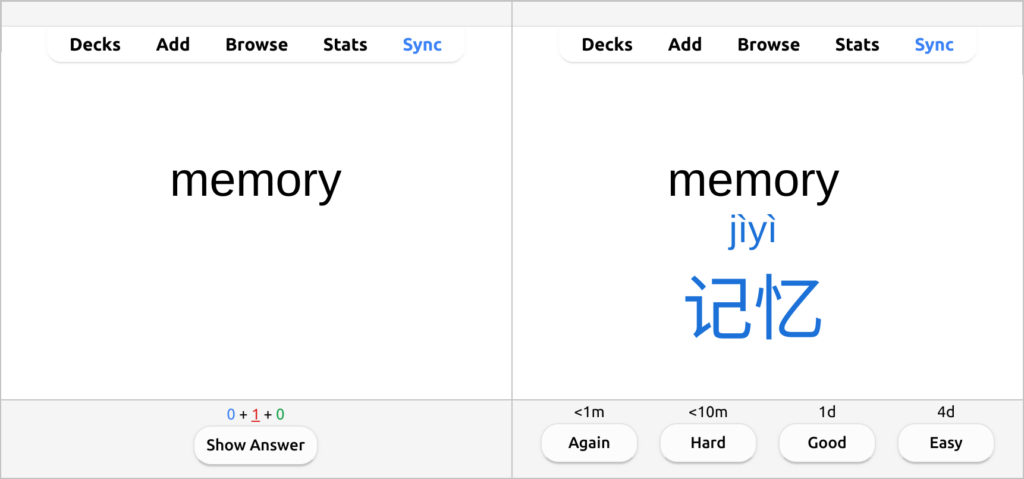 Flashcards are often viewed as a silver bullet, promising swift mastery of characters, words and more, but relying on flashcards too much has serious drawbacks, and if you’re not careful, they can hinder more than they help.
Flashcards are often viewed as a silver bullet, promising swift mastery of characters, words and more, but relying on flashcards too much has serious drawbacks, and if you’re not careful, they can hinder more than they help.
Tune in to the Hacking Chinese Podcast to listen to the related episode:
Available on Apple Podcasts, Google Podcast, Overcast, Spotify, YouTube and many other platforms!
If used correctly, flashcards can offer some benefits for Chinese learners, something I covered in the previous article in this series. Please read the article for full details, but here’s a summary of the advantages:
- An efficient way to learn the basic meaning of characters and words
- Excellent for learning to write characters by hand
- Immediate feedback about what you don’t know
- Flexible and always available, enabling you to use time efficiently
- Measurable progress and increased motivation
- Collect notes about the vocabulary you learn
Here’s a list of all the articles in this series:
- Why flashcards are great for learning Chinese
- Why flashcards are terrible for learning Chinese (this article)
- How to best use flashcards to learn Chinese
Flashcards are good for some things, but they’re not a silver bullet
The benefits of flashcards make students consider them seriously, and rightfully so. However, they also make some students believe that flashcards are a silver bullet that will teach them everything they need to know.
This is simply not true.
There are many drawbacks to relying on flashcards, which is what I will discuss in this article. Many students spend too much time with flashcards and, as a result, their progress with Chinese suffers.
What is a flashcard anyway?
Before we continue, let’s discuss what a flashcard is. If you read the previous article in this series or know everything about flashcards already, you can skip this section.
A traditional flashcard is a piece of paper with a question (usually called a prompt) on the front and an answer on the back. You look at the front, try to recall the information on the back, and then flip it over to verify if you were right or wrong.
In theory, you can put anything on the front and anything on the back. Digital flashcards don’t need to have only two sides either and also allow for having pictures, audio and even video on them.

You can have prompts with only one word on them (such as “memory”, and you’re supposed to write 记忆/記憶) or prompts that take minutes to go through (a long paragraph with one word blanked out). Similarly, you can have answers that are very simple (such as the two characters for “memory”) or answers that are very complex and contain full dictionary entries and personal notes for the vocabulary item in question.
With some ingenuity, you can create a flashcard for almost anything you want to remember. This means that it’s hard to discuss flashcards in general because the pros and cons depend on exactly how you use them.
Here, however, I will mostly discuss flashcards as they are commonly used to learn languages. This means short prompts and short answers, sometimes with pictures and/or audio.
Why flashcards are bad for learning Chinese
Having covered the main reasons why flashcards should be considered carefully before being excluded from your study routines, let’s argue the opposite case and highlight some limitations with flashcards. These taken together mean that an over-reliance on flashcards can be bad for learning Chinese.
However, it’s important to keep in mind that it could be that the tool is not the problem, but rather how it’s used. This means that many of the disadvantages of flashcards might come from how they are used rather than the flashcards themselves.
Below, we will discuss seven downsides of flashcards and see if and how we can work around them. They are:
- Lack of context
- Low transferability
- Shallow processing
- Not meaning-focused
- Time waste and opportunity cost
- Measurable progress (to a fault)
- Great for reviewing, not for learning new things
Let’s get started!
Flashcard problem #1: Lack of context
Flashcards typically focus on isolated parts of the language: a word, a character or even a character component. Not only that, they only focus on one aspect of that vocabulary item, such as its pronunciation or meaning. As discussed in the previous article, this is good for isolating exactly what you don’t know so you can focus on it more, but it also has drawbacks.
The main problem is that meaning in a language is not conveyed through isolated pieces, but through a unified whole:
- Thinking that you truly know a character just because you got it right ten times in your flashcard app is delusional
- Thinking that you can read just because you know all the characters in a text is equally misguided
- Thinking that you will understand spoken Chinese just because you can identify all the syllables in isolation is even further from the truth
Much of what you need to know to use Chinese functionally can only be learnt in context, which is hard or impossible to implement in flashcards. Can we work around this problem?
In theory, yes. You can use very long prompts with a whole paragraph of text, or a longer recorded passage. That way, you will get context on the flashcards themselves. You could also build an app that used different prompts each time for the same answer (a flashcard that has many front sides but only one back side, so to speak).
However, both these solutions have their own drawbacks. In the first case, you could argue that you might as well switch to extensive reading in general and skip the flashcard. Reading is also spaced repetition but avoids most of the drawbacks with flashcards. It’s also more fun!
In the second case, it would be hard to programmatically choose prompts that give you just enough information without also giving the answer away. Creating these flashcards manually would be a nightmare.
Flashcard problem #2: Low transferability
When learning anything, you need to make sure that the things you learn also transfer well to the intended use case. Your goal is to improve your Chinese, not get good at flashcards, after all.
To work properly, flashcards need to ask limited questions. They also need to provide a prompt that makes it possible to recall the correct answer. This combination creates a problem where students can learn the answer to a question without actually understanding the language involved, which means the knowledge can’t be transferred to real-world situations.
For example, imagine a flashcard designed to review the pronunciation of a Chinese character. Maybe the prompt then contains an example sentence, because without one, there are too many possible answers. You might then learn to answer correctly based on the example sentence rather than the character in question.
Can we work around this?
Maybe. This problem stems from the fact that flashcards are static and orderly, while real language is dynamic and chaotic. It has partly the same potential solutions as the lack of context above, but as mentioned, these solutions are also hard to implement.
Flashcard problem #3: Shallow processing
 If you read the previous article in this series, you know that the two principles underlying the effectiveness of flashcards are active recall and deep processing. However, the fragmentary nature of flashcards can also stop you from processing the language deeply.
If you read the previous article in this series, you know that the two principles underlying the effectiveness of flashcards are active recall and deep processing. However, the fragmentary nature of flashcards can also stop you from processing the language deeply.
Flashcards make you focus on simple one-to-one relationships, learning that A = X, and B = Y. Compared to encountering these vocabulary items in real written or spoken Chinese, you’re only touching the surface. Yes, you will remember that A = X and Y = X, but that’s only the beginning. Flashcards need to be unambiguous to work well, but dealing with disambiguation is part of what it means to understand a language.
To get around this problem, you need to break one of the fundamental principles of flashcards, namely that they should focus on one specific piece of knowledge. You could do that, of course, but it would then also undermine other advantages of flashcards.
For example, if you ask more than one question about a vocabulary item at once, and you get some right and some wrong, you can’t isolate the things you need to work more on from those you already know. Similarly, if a prompt would have more than one correct answer, it would be hard to track which of these you actually know.
Flashcard problem #4: Not meaning-focused
Languages are systems of communication. We use them when we want to convey meaning to other people, or when we want to understand something others want to convey to us. In general, language learning activities that focus on meaning are preferable to those that don’t.
- Meaning-focused input
- Meaning-focused output
- Language-focused learning
- Fluency development
Analyse and balance your Chinese learning with Paul Nation’s four strands
Three out of four focus on meaning, and activities focusing on the language itself, including studying grammar, characters, pronunciation and so on, are confined to a single strand, just one-fourth of total study time. And flashcards are supposed to fit in there, too.
There is something very artificial about practising a tiny aspect of Chinese for the sole reason of practising that tiny aspect. Compare that with using Chinese to listen, speak, read or write, where the primary goal is to communicate.
- With language-focused activities, you drill certain aspects of the language in the hope that this will help you to communicate later
- With meaning-focused activities, you communicate right away and skip an intermediary step that isn’t always useful
Part of the reason why many students find flashcards boring is because this type of learning is too far removed from the real world. Combined with the problem of low transferability discussed above, this is also why many researchers and educators don’t like flashcards either.
This is an inherent problem with flashcards. It’s hard to see how they could be made to focus on meaning.
Flashcard problem #5: Time waste and opportunity cost
While it’s possible to control how much time you invest in any learning activity, some students tend to rely too much on flashcards. This means that even though flashcards can be useful, they neglect other forms of learning, especially listening and reading.
I have worked with Skritter for almost ten years and regularly encounter students who spend a shocking amount of time on flashcards. Some do only flashcards! If dedicated vocabulary learning takes up a majority of your total study time, you’re doing something wrong, in my opinion.
I have personally spent at least a thousand hours on flashcards, but while that sounds crazy, it only makes up a small fraction of the total time I’ve invested into learning Chinese over more than 15 years. I would estimate that when I relied the most on flashcards, it still didn’t exceed one-fifth of my total study time, and most of the time, it was much less than that.
The easy solution here is just to not use flashcards too much. There are two problems with that, however:
- First, how much is too much? I just mentioned one-fourth of your study time for all language-focused learning. Maybe one-tenth for flashcards would be okay?
- Second, it’s motivating to see the number of vocabulary items learnt go up and complete a certain set of characters and words (see below). Some students even become addicted to flashcard apps!
Flashcard problem #6: Measurable progress (to a fault)
Normally, measurable progress is good. By benchmarking your learning and logging your study activities, you are almost guaranteed to both make progress and stay motivated, even when making your way over the intermediate plateau.
However, you need to make sure that you’re measuring the right things. As I’ve already said, the goal is not to get good at flashcards but to learn Chinese. They are related, but they are not the same thing. Don’t mistake the map for the territory:
- Scoring well on the HSK does not necessarily mean that your Chinese is good
- Getting good grades in your course doesn’t mean that your Chinese is good either
- Knowing many words in a flashcard app means almost nothing in and of itself
It’s hard to get around the problem of measuring the wrong thing because it’s not as easy as saying that you should start measuring the right things instead. If your goal is to become conversational in Chinese, how do you measure that? It’s really hard!
Thus, many students use vocabulary as a proxy for how much Chinese they know. They then gradually come to think of learning Chinese as learning more words in their favourite app. If you are such a student and have read this far, I hope that you’ll realise that just because it’s measurable, it doesn’t mean it’s good.
Read more here: Measuring your language learning is a double-edged sword
Flashcard problem #7: Great for reviewing, not for learning new things
The final issue with flashcards as they are commonly implemented is that they are great for remembering what you have already learnt, but bad for teaching you entirely new things. It can be argued that remembering what you have previously studied is part of what learning means, but here I’m referring to new material, such as a new character, word or grammar pattern.
Learning works best when you can connect what you want to learn to something you already know. A concrete example of this might be to understand the building blocks of a character to make sense of its structure and meaning. Another would be to make sure you understand the composition of the character before you try to remember how to write it by hand.
The building blocks of Chinese, part 1: Chinese characters and words in a nutshell
Thus, simply adding a bunch of characters and words to your flashcard app and starting hammering away at them in review mode is not very good. If you stop for each new item and study it carefully, trying to understand both the character word itself and its wider function in the language, that’s great, but most apps don’t do this. Skritter is an exception, where we have a separate learning mode so you can familiarise yourself with the vocabulary before you start reviewing it.
In essence, a review mode is built to help you maintain knowledge over time, it’s not designed to give you a good first impression of the vocabulary you’re trying to learn. You might want to learn much more than can comfortably be contained in a flashcard.
This problem with flashcards can be dealt with easily compared with the others mentioned above: only create flashcards for words you’ve learnt elsewhere. This might be vocabulary you’ve been taught in class, that you’ve encountered in a graded reader or something that came up in a conversation you had.
I’ve argued elsewhere that spaced repetition apps don’t need to rely on rote learning, but you certainly can use rote learning if you’re not careful. Many apps also encourage you to do so, or at least do little to persuade you to stop.
The role of flashcards in a balanced approach to learning Chinese
That was a long list of reasons to not use flashcards, and even if some of the problems can be worked around, it should lead you to the question of whether or not you actually should use flashcards at all.
The answer is “Yes, you should, but it depends on how you use them”. Exactly how to incorporate flashcards in a balanced approach to learning Chinese will be the subject of the final article in this series. Stay tuned!

2 comments
When I was studying Japanese, I fell into the trap of overusing flashcards to the point that it was crowding out time on other things, like reading and listening. I’ve just started into Mandarin recently (dabbled a couple of times in the past, but didn’t go super-far with it), and I’m trying to avoid running into this same issue. Knowing a lot of Japanese vocabulary is making it easier to pick up words in Chinese, though—in some cases, it’s just a matter of mapping a new pronunciation onto a word I already know (自然 looks identical in both languages), or getting used to seeing the simplified form of a character (Japanese 電話 vs. Chinese 电话). I’m hoping I’ll be able to start working my way to sufficiently comprehensible reading input a little faster so I don’t get so bogged down in atomized drills (which, as you’ve said, can be useful but certainly have their limitations).
I appreciate your site—keep up the good work!
Thank you for sharing your experience! It’s easy to get bogged down in flashcards, mostly because it’s easy to know what to do and the progress is treacherously measurable. Reading and listening is generally better (although there’s no reason you can’t do both), but input has a less direct impact on your learning and doesn’t feel as useful. Good luck!